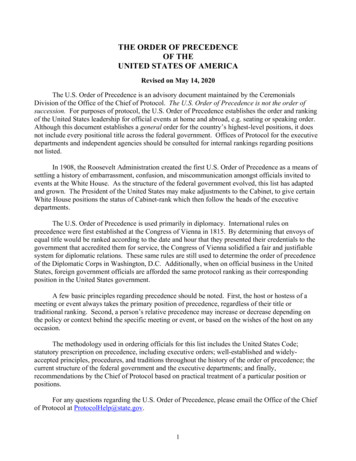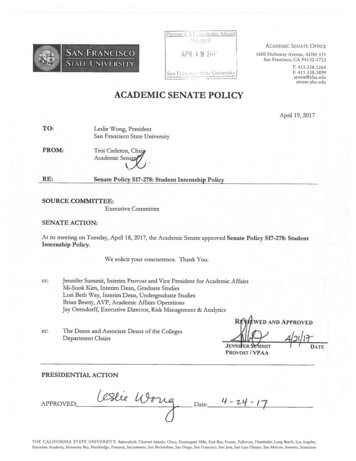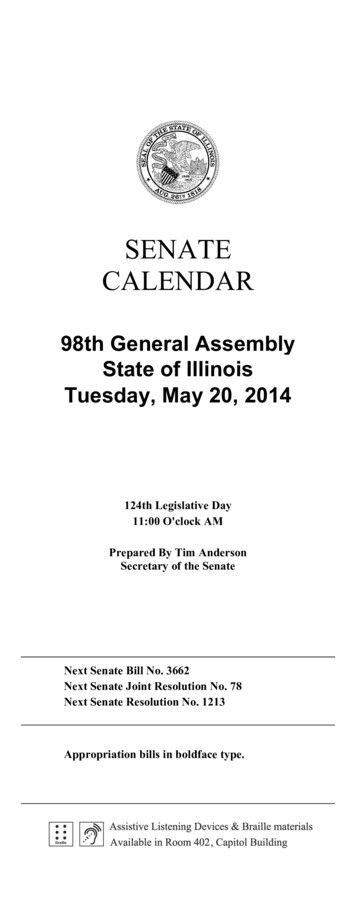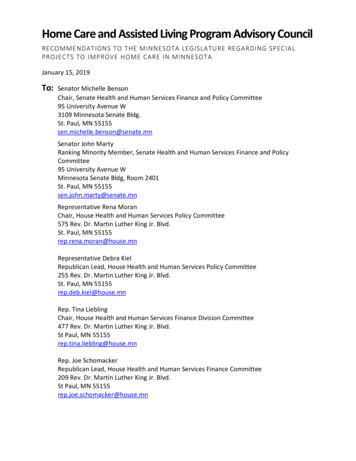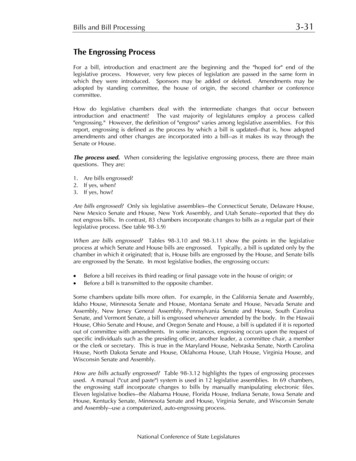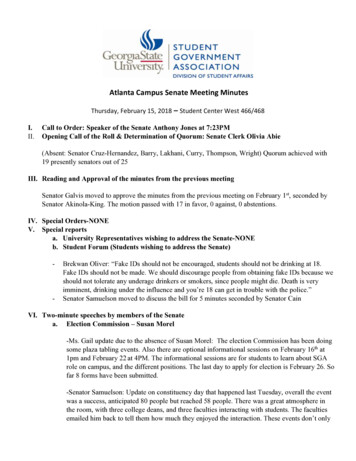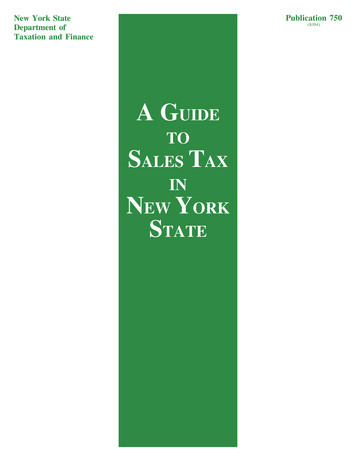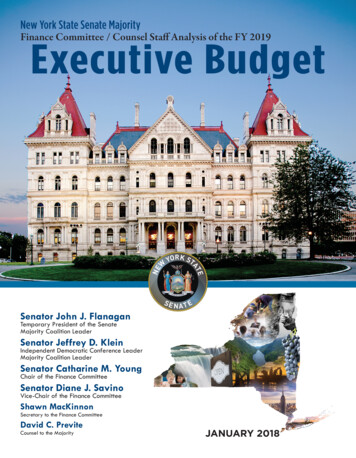
Transcription
New York State Senate MajorityFinance Committee / Counsel Staff Analysis of the FY 2019Executive BudgetSenator John J. FlanaganTemporary President of the SenateMajority Coalition LeaderSenator Jeffrey D. KleinIndependent Democratic Conference LeaderMajority Coalition LeaderSenator Catharine M. YoungChair of the Finance CommitteeSenator Diane J. SavinoVice-Chair of the Finance CommitteeShawn MacKinnonSecretary to the Finance CommitteeDavid C. PreviteCounsel to the MajorityJANUARY 2018
CHAIRTHE SENATESTATE OF NEW YORKALBANY OFFICEROOM 428STATE CAPITOLALBANY, NEW YORK 12247(518) 455-3563FAX: (518) 426-6905FINANCESTANDING COMMITTEESHOUSINGTRANSPORTATIONCATHARINE M. YOUNGSENATOR57TH DISTRICTDISTRICT OFFICEWESTGATE PLAZA700 W. STATE STREETOLEAN, NEW YORK 14760(716) 372-4901FAX: (716) 372-57401-800-707-0058
Report of theSenate Finance CommitteeSTAFF ANALYSIS OF THEFY 2019 EXECUTIVE BUDGETAs Prepared by the Senate Majority Coalition Finance Committee / Counsel StaffShawn MacKinnonSecretary, Finance CommitteeDavid PreviteCounsel to the MajorityThomas Havel, Deputy Secretary, Senate Finance CommitteeJames Curran, First Assistant Counsel, Senate Counsel ProgramFinance StaffKevin GannonNicholas AudiMaria LoGiudiceBrendan BoylePhilip ManuliAllison BradleyLauren MelendezSharon CarpinelloMark NachbarJohn DiVitoSteven RodwayJeffrey DeGironimoDave ThomanPeter DraoCharles VaasJames EaganBenjamin EddyJoanne FogartyPeter FolandNicole FoscoCounsel/Program StaffBarbara McRedmondCarmen J. BarberJoseph MessinaNicola ColemanPaul MideyKen ConnollyCharles PensabeneRobert FarleyAnthony PiscitelliJonathan FedermanMichael PottettiJoseph FoskettJillian SauerColleen GlavinNicole StewartJonathan GravesAllison GoldDave GruenbergLisa HarrisMaureen HarrisBenjamin KosinskiDirector, Council on Health Care FinancingThomas WickhamPublication EditorJason P. Clark
TABLE OF CONTENTSSECTION ONE: HIGHLIGHTS OF THE FY 2019 BUDGETOVERVIEW OF THE FY 19 BUDGET – FINANCIAL PLAN TABLES . 1SUMMARY OF AGENCY SPENDINGEducation . 23Higher Education . 34Health – Medicaid . 43Transportation . 70Environmental Conservation, Agriculture and Housing . 76Public Protection . 91Economic Development . 103Mental Hygiene . 112Human Services . 122General Government and Local Government Assistance. 136Receipts, Taxes and Fees. 152SECTION TWO: SENATE ISSUES IN FOCUSMiddle Class Income Tax Cut / Child and Dependant Care Credit . 159New York State Property Tax Relief . 161New York City Property Tax Growth . 168Foundation Aid . 172Charter Schools . 176College Affordability . 179State Infrastructure and Settlement Funds . 182Transportation Capital Programs . 187Congestion Pricing . 192Heroin and Opiod Crisis . 195Executive Criminal Justice Proposals . 205Executive Proposal on Ethics and other Governmental Operations . 207State Spending Cap . 216Minimum Wage - 15 per hour (Update) . 218Paid Family Leave . 225Workforce Update . 229Federal Tax Changes. 232Water Quality and Flood Funding . 236Executive Workforce Development Proposal . 239Energy and Environment . 241Local Government Impact Shared Services and Continued Savings to Counties. 243SECTION THREE: SUMMARY OF ARTICLE VII LEGISTLATION AND APPENDICESExecutive Budget Public Hearing Schedule . 247Summary of Article VII Bills. 248
SECTION ONEHIGHLIGHTS OF THE EXECUTIVEBUDGET
OVERVIEWThe State Senate Majority has continued to workin a bi-partisan way to protect the hard workingtaxpayers of the State of New York by enactingState budgets that reflect progress in making NewYork more affordable, creating more opportunityand increasing security. Ultimately, these goalscan be achieved by controlling taxes andspending, creating jobs, building a better businessenvironment, and investing in critically importantareas like public safety, education, health care andthe environment.The Executive Budget extends for the eighthstraight year proposed spending restraintsthrough a self imposed two percent spending capon State funds that has to date saved the taxpayersof New York over 41 billion. While continuingto commit to this fiscal restraint the Executive hasproposed significant investments in education,health and safety, as well as infrastructureimprovements. The Executive has proposed anumber of gap closing actions to eliminate a 4.4billion dollar deficit for FY 2019. Theseproposals in turn reduce projected out yearfinancial gaps.To reduce those financial gaps the ExecutiveBudget utilizes financing mechanisms, such asproposed new taxes on for-profit insurancecompanies that recently benefitted from federaltax changes, a surcharge on opioid prescriptions,an internet conformity tax, an elimination ofstatutory tax deductions for energy servicecompanies and the deferral of business tax creditsin excess of 2 million. These proposed actions inconjunction with assuming proceeds from theconversion of a not-for-profit health insuranceplan to a for-profit company raises approximately 1 billion in additional revenue. The ExecutiveBudget estimates that the General Fund willremain in balance on a cash basis for FY 2019 andFY 19 Executive Budget Summarythe Financial Plan projects a four-year GeneralFund surplus of 1.367 billion.The Executive Budget revenue outlook continuesto reflect the recent uncertainty and atypicalreceipts patterns the State has been experiencing,and the Executive has again adjusted revenueprojections. In comparison to the FY 2018 MidYear update, tax receipts projections have beenrevised upward by 1.9 billion, buoyed by astrong surge in tax prepayments. For FY 2019,the Executive is anticipating an overall decline of2 percent in State tax receipts, driven by 1.9billion in personal income tax prepaymentsshifted into the prior fiscal year, which is partiallyoffset by expected increased business andsales/use tax collections.The FY 2019 Executive Budget proposes tocontinue language within the appropriation billsproviding the Executive with broad powers toreduce certain local assistance payments by auniform amount in the event that any revenue tothe State including federal aid is reduced fromprojected levels.In addition to this proposal the Executive hasadvanced language allowing the Executive toreduce funding for local assistance programs ifrevenues projected to support those specific localassistance programs are not realized throughoutthe fiscal year. In the event of a shortfall in taxreceipts in excess of 500 million, the Director ofthe Budget would be authorized to uniformlyreduce local assistance programs. This languageprovides additional fiscal powers to the Executivebranch to alter the Enacted Budget withoutapproval of the Legislature.In conjunction with these two proposals the FY2019 Executive Budget includes broadPage 1
interchange language within the appropriationbillsFINANCIAL PLANDespite the current year shortfall in receipts, theFY 2019 Executive Budget financial plan projectsa structural surplus through FY 2022 of 1.4billion after tax actions. FY 2019 All Fundsspending is projected at 168.2 billion, anincrease of 3.8 billion or 2.3 percent.FY 2019 ALL FUNDS SPENDING(billions of dollars)20182019ChangePercent 164.5 168.2 3.82.3%FY 2019 State Operating Funds spending isprojected at 100 billion, an increase of 1.9billion or 1.9 percent from FY 2018.FY 2019 STATE OPERATING FUNDS SPENDING(billions of dollars)20182019ChangePercent 98.1 100.0 1.91.9%BUDGET SURPLUS / (GAP)The Executive Budget estimates that the GeneralFund will remain in balance on a cash basis forFY 2018 and projects a four year structuralsurplus of 1.4 billion.Executive Budget Surplus / (Gap) Estimate(millions of dollars)FY 2019 0FY 2020( 127)FY 2021 256FY 2022 1,238Structural Surplus 1,367Page 2FY 2019 Budget Gap Closing Plan(millions of dollars)Mid‐Year Surplus / (Gap) Estimate( 4,443)Agency Operations 446Local Assistance 1,317Captial Projects / Debt Management 569Initiatives and Investments 340Total Spending Changes 2,672Resource ChangesTax ActionsTotal Resource ChangesExecutive Budget Surplus / (Gap) 736 1,035 1,771 0The Executive Budget estimates a FY 2019General Fund cash deficit of 4.4 billion to beclosed through net spending reductions of 2.7billion offset by net resource changes of 736million.RECEIPTSThe Executive Budget projects FY 2019 StateOperating Funds receipts at 96.1 billion, adecrease of 2 billion or 2 percent. FY 2019 AllFunds receipts are projected to decrease from 164.6 billion to 163.2 billion, a decrease of 1.4 billion or 0.9 percent. The All Funds receiptsdecrease reflects a projected 1.9 billion declinein personal income tax revenue as a result of largeprepayments in December 2017 as a result ofchanges to Federal Tax Law. Receipts for FY2020 include approximately 1.5 billion inincreased personal income taxes resulting fromchanges to Federal Tax Law that will increasestate tax liability.RECEIPTS(billions of dollars)20182019State Operating Funds 98.1 96.1All Funds 164.6 163.2Change Percent( 2.0)‐2.0%( 1.4)‐0.8%FY 19 Executive Budget Summary
The FY 2019 Executive Budget includes no taxreductions in FY 2019 and FY 2020 and only 74million in FY 2021 and FY 2022. Instead, theExecutive imposes numerous new and increasedtaxes and fees. The Executive Budget includes 586 million in tax and fee increases in FY 2019,growing to 973 million in FY 2020.RESERVESThe Executive Budget projects a FY 2019General Fund closing balance of 5.1 billion, adecrease of 4.05 billion over the projectedclosing balance for FY 2018. Included within theFY 2018 reserve total is: 1.8 billion for statutoryreserves; 39 million in the Community ProjectsFund; 155 million for potential laboragreements; 21 million in a contingency reservefor claims made against the State; and 500million for debt reduction. There is also 4.7billion in financial settlement proceeds, of which 2.1 billion is projected to be disbursed by the endof FY 2018, and a 1.9 billion undesignated fundbalance, which according to the Executive, isderived from the pre-payment of taxes.MAJOR SPENDING AREA HIGHLIGHTSHEALTH - MEDICAIDThe FY 2019 Executive Budget projects AllFunds Medicaid spending of 64.3 billion, anincrease of 0.9 million or 0.1 percent overcurrent year spending. When including the 7.9billion local share of Medicaid, the grossspending on Medicaid grows to 72.37 billion, anincrease of 193 million or 0.3 percent overcurrent year spending.The FY 2019 Executive Budget projects AllFunds DOH Medicaid spending of 57.7 billion,an increase of 1.6 million or 2.8 percent overcurrent year spending.Global Spending Cap and Related ProvisionsFY 19 Executive Budget SummaryThe Executive proposes extending the stateMedicaid Global Cap for one year through FY2020. Enacted in FY 2012, the Global Cap limitsDOH Medicaid spending growth to the ten-yearrolling average of the Medical component of theConsumer Price Index (CPI), which is currentlyestimated at 3.2 percent, in order to containMedicaid program growth and spendingincreases. Also extended for one year as part ofthe Executive’s proposal, is the authority for theCommissioner of Health to develop a MedicaidSavings Allocation plan should state expendituresexceed the cap amount.In statute, there are certain select exemptions tothe Global Cap calculation, including funding forthe minimum wage requirements enacted in FY2017. The Executive also includes appropriationlanguage stating that in the event that receipts areless than assumed in the FY 2019 Financial Plan,payments may be reduced in accordance to awritten allocation plan promulgated by theDirector of the Budget.The Executive proposes to achieve savings of 281.5 million in FY 2019 and 379 million inFY 2020 to the Medicaid Global Cap byoffloading supplemental programs, including theValue Based Payment Quality Incentive Program(VBP-QIP) and the Equity InfrastructurePerformance Program (EIPP) from Medicaid tothe Essential Plan and utilize remaining FederalTrust Fund balances to fund the non-federalshare.The Executive proposes to achieve 425 millionin Financial Plan relief by shifting 425 millionof non-DOH Medicaid expenses into the GlobalCap. The Executive includes numerous proposalsto achieve savings within the Global Cap in orderto offset this transfer.DOH State MedicaidThe FY 2019 Executive Budget projects DOHState Medicaid spending to be 20.6 billion,Page 3
which is above the Global Cap spending amount,an increase of 1.2 billion or 6.3 percent over FY2018. Since statute excludes certain spendingincreases, such as minimum wage increases, fromthe Global Cap calculation, Global Cap spendingis projected to remain within required parameters,at 18.8 billion, an increase of 593 million or 3.2percent from FY 2018.The impact of the minimum wage increase onMedicaid is as follows: FY 2018 22 million; FY2019 703 million; FY 2020 1,022 million; FY2021 1.111 million; FY 2022 1.193 million.These funds are allocated to implement newminimum wage requirements, and will be used tosupport direct salary costs and fringe benefits forhealth care workers reimbursed by the Medicaidprogram.The FY 2019 Executive Budget continues thestate takeover of the local share of Medicaidcosts. The state is expected to provide over 3.3billion in relief to local districts in FY 2019. Thisreflects total relief provided to localities of 15.5billion, since FY 2013.Proposed FY 2019 Medicaid Redesign Team(MRT)The Executive proposes multiple initiativesimplementing FY 2019 MRT. Many of the FY2019 Executive proposals require legislativeaction while others could be accomplishedadministratively. Essential Plan Initiatives- State savingsestimated to be 282 million. Medicaid Pharmacy Initiatives- State savingsestimated to be 45.2 million. Transportation Initiatives- State savingsestimated to be 11.7 million. Managed Care Initiatives- State savingsestimated to be 70.3 million. Hospital Initiatives- State savings estimatedto be 18 million.Page 4 Long Term Care Initiatives- State savingsestimated to be 180.1 million. Other Initiatives- State savings estimated tobe 100.1 million.The savings from these proposals offset 675.8million demand on state spending within theGlobal Cap in FY 2019 and allow Global Capspending to remain within required parameters.HEALTH – PUBLIC HEALTHHealth - Public HealthThe FY 2019 Executive Budget recommendsPublic Health spending, excluding Medicaid andthe Essential Plan, at 5.38 billion, an increase of 271.5 million, or 5.3 from current year levels.Early Intervention Program Reform (EI)The FY 2019 Executive Budget proposes a seriesof changes to the Early Intervention (EI) Programthat would result in a net State savings of 3.2million in FY 2019, increasing to 9.5 million inFY 2019. Additionally, these proposed changes toEI services, would provide an estimated annualsavings of 12 million to local municipalities. Forfurther detailed information, refer to Part O of theHealth and Mental Hygiene proposal in theArticle VII section of the report.Consolidation of Public Health ProgramsThe FY 2019 Executive Budget recommends theconsolidation of 30 public health appropriationsinto four pools, while also reducing funding ofthese proposed pools by 20 percent. Theproposed consolidation shifts 28 million ofHCRA funded programs to General Funds. Thisproposal would achieve net savings of 9.2million in FY 2019.FY 19 Executive Budget Summary
Statewide Health Care Facilities TransformationProgram IIIThe FY 2019 Executive Budget recommends upto 425 million in capital funding for theStatewide Health Care Facilities TransformationProgram III, of which 300 million would becapital bonds disbursed through DormitoryAuthority of the State of New York (DASNY),and 125 million would be from settlement funds.This program would provide health care facilitiesfunding to support capital projects, debtretirement, working capital and certain noncapital needs that facilitate transformativeactivities intended to improve access tohealthcare services.HUMAN SERVICESThe FY 2019 Executive Budget recommends anincrease in All Funds cash disbursements of 318.2 million or 3.7 percent over FY 2018 for allHuman Services agencies.The FY 2019 Executive Budget proposes AllFunds State Operations spending, includingGeneral State Charges, of 354.9 million for theOffice of Children and Family Services. This isan increase of 2.4 million or 0.7 percent. TheExecutive recommends a staffing level of 2,907FTE, which is a reduction of 58 FTE.The Executive provides FY 2019 All Funds Aidto Localities appropriation authority of 3.2billion, a decrease of 41.7 million or 1.3 percentfrom FY 2018 levels. This decrease can beattributed to reductions of: 41.4 million from thediscontinuation of State reimbursement to NewYork City related to the Close to Home initiative; 23.6 million from the elimination of Legislativeinitiatives; and 6.7 million in miscellaneousreductions. These reductions are offset by a 30million increase in General Fund support for childcare subsidies.FY 19 Executive Budget SummaryFY 2019 All Funds cash spending is projected tobe 2.4 billion, a decrease of 47.4 million or 1.9percent.The FY 2019 Executive Budget includes ArticleVII legislation to renew various programs that areset to expire in FY 2018, including the Close toHome initiative for juvenile delinquents in NewYork City, for an additional five years, and theYouth Development Program, for an additionalthree years. Legislation is also included toauthorize the Dormitory Authority of the State ofNew York to provide capital design andconstruction services to OCFS.The FY 2019 Executive Budget includes a new, 100 million miscellaneous Aid to Localitiesappropriation for New York State, New YorkCity and county costs related to theimplementation of raise the age.For the Office of Temporary and DisabilityAssistance, the FY 2019 Executive Budgetproposes All Funds State Operations spending,including General State Charges, of 326.8million, an increase of 3.1 million or 0.9 percentfrom FY 2018. The Executive maintains thecurrent staffing level of 2,006 FTE.The Executive proposes FY 2019 All Funds Aidto Localities appropriation authority of 5.2billion, an increase of 76.1 million or 1.5 percentfrom FY 2018. This change can be attributed toincreases of: 14.7 million for Safety NetAssistance; 5 million for SSI State supplementpayments; 99.3 million for Family Assistanceand Emergency Assistance to Families; 4million for the Summer Youth Employmentprogram; and 1.4 million for homeless housingand preventive services.These increases are partially offset by a 23million reduction in TANF support for child caresubsidies, the transfer of 3 million for NurseFamily Partnership to the Department of Health,Page 5
and the elimination of 21.3 million inLegislative initiatives.The Executive Budget increases appropriationauthority for the Family Assistance and SafetyNet Assistance programs by 14.7 million and 99.3 million, respectively.A total ofapproximately 2.8 billion in public assistancespending is projected, driven by a total projectedcaseload of 558,720.The Executive proposes 1 million in newfunding for a program to provide comprehensivesupport and case management services for at-riskyouth, in particular unaccompanied childrenentering the United States and residing in Nassauand Suffolk Counties.For the Workers’ Compensation Board, the FY2019 Executive Budget recommends an AllFunds cash spending amount of 216.5 million,an increase of 19.2 million or 9.7 percent fromFY 2018. The cash increase is primarily drivenby 17.3 million in capital spending, 1.2 millionin General State Charges, and 4.3 million inState Operations.The FY 2019 Executive Budget provides 19.2million in All Funds appropriation support for theDivision of Veteran’s Affairs, a decrease of 1.6million from FY 2018. This decrease relates tothe elimination by the Executive of Legislativeinitiatives. The Division’s staffing level of 98FTE is unchanged.MENTAL HYGIENEThe FY 2019 Executive Budget includeslanguage to authorize counties outside of NewYork City, at local option, to provide rentalsubsidies to Public Assistance recipients withmedically diagnosed HIV infection, as defined bythe AIDS Institute of the New York StateDepartment of Health. Counties would beauthorized, in accordance with a plan approvedby OTDA, to cap housing expenses for theseindividuals at no more than 30 percent of theirincome. This proposal would also amend existinglaw granting authorization to New York City toallow rental subsidies to be provided to publicassistance recipients with medically diagnosedHIV infection, as defined by the AIDS Institute.Excluding Unemployment Insurance (UI), the FY2019 Executive Budget recommends All Fundsspending of 152 million for the Department ofLabor, a decrease of 15.3 million or 9.1 percentfrom FY 2018. This decrease can be attributed tothe elimination by the Executive of 15.3 millionin Legislative Initiatives. The Executive reducesappropriation authority for the UI program by 50million, to 2.85 billion, as a result of a decreasein UI benefit payments due to reduced utilizationand the strong health of the fund.Page 6The FY 2019 Executive Budget recommends 7.2 billion in All Funds cash disbursements inMental Hygiene spending, an increase of 254million, or 3.7 percent. This includes 1.8 billionin Department of Health (DOH) disbursementsfor Office for People with DevelopmentalDisabilities (OPWDD) services, an increase of 492 million.The Executive proposal supports s a totalworkforce in Mental Hygiene of 33,624, adecrease of 307 FTEs, primarily reflecting areduction in State services in the Office of MentalHealth (OMH). No layoffs are anticipated in FY2019, all FTE decreases would be accomplishedthrough attrition.The Executive Budget includes 146 million inState funds, and increase of 132 million, to fundthe second year of a salary enhancement for directcare and support workers under the auspices ofmental hygiene agencies. The Executive Budgetalso includes 64 million, an increase of 44million, to support the cost to not-for-profitmental hygiene agencies impacted by theminimum wage increaseFY 19 Executive Budget Summary
The Executive Budget proposes in OMH anadditional reduction of 100 adult or children’sbeds if there is a consistent 90-day vacant period.The Executive proposes developing jail-basedrestoration to competency units that would resultin approximately 50 forensic bed reductions. TheExecutive estimates that the reinvestment intocommunity services will increase by 11 millionannually as a result of actions in FY 2019. Thereare no proposed closures of State-operatedpsychiatric centers for FY 2019; however, theExecutive will continue with the planned transferof children’s inpatient services from WesternNew York Children’s Psychiatric Center toBuffalo Psychiatric Center.The Executive Budget proposal recommendsstatic funding of over 200 million addressing theheroin and opioid epidemic. New initiatives arenot proposed to combat the opioid/heroinepidemic; the recommendations do maintain prioryear investments.SCHOOL AIDThe FY 2019 Executive Budget provides 26.36billion in school aid, an increase of 769 millionor 3.0 percent above the 2017-18 school year.This proposal provides for an increase of 317million for expense based and other categoricalaids for the 2018-19 school year. Under theExecutive Budget, Foundation Aid is increasedby 337.6 million over the prior year. Additionalfunding of 64 million is provided in a fiscalstabilization fund with distribution of such fundsto be negotiated by the Legislature.Anadditional 50 million in new funding withinFoundation Aid is provided for Communityschools.The Executive Budget funds expense base aidsand other categorical initiatives at present lawlevels for an increase of 317 million. However,the Executive Proposes beginning with the 201920 school year to limit growth in BOCES Aid andFY 19 Executive Budget SummaryTransportation Aid to two percent above the prioryear. Also beginning in 2019-20, if the statewidegrowth in Building Aid in the current year isgreater than two percent, Building Aid would bereduced by an efficiency factor.The Executive Budget increases Foundation Aidby 337.6 million and distributes 81.4 percent ofthe increase in Foundation Aid to high needsschool districts. When looking strictly at relativewealth, the Executive proposal distributes 98.4percent of the proposed Foundation aid increaseto low wealth school districts including NewYork City. All school districts receive an increasein Foundation Aid under this proposal with 179districts receiving a minimum one quarter of onepercent year over year increase.The Executive Budget provides for a 200 millionCommunity Schools set-aside which is anincrease of 50 million above 2017-18 levels.This set-aside is included in total Foundation Aid.Similar to FY 2018, the 150 million set-aside forFY 2019 retains its flexibility, however, the 50million set-aside for FY 2019 must be used tosupport the transformation of schools intoCommunity Schools.The Executive Budget includes over 800 millionin funding for Universal Pre-Kindergarten in the2018-19 school year with most of that intendedfor four-year old children.The school aid run reflects 415.56 million infunding which includes the consolidation of 30.53 million for Priority Prekindergarten (PPK)into the 385 million for the Universal PreKindergarten Program. The Executive alsocontinues funding of 340 million forPrekindergarten for four year olds as part of aSenate initiative to fully fund Universal PreKindergarten enacted in the FY 2015 budget.The Executive proposes capping STAR benefitsat 2017-18 levels, beginning with the 2018-19school year, in an effort to limit state spending onPage 7
STAR. The Executive estimates FY 2019 savingsof 49 million from this proposal. Current lawallows the growth of STAR benefits at a rate notto exceed two percent annually.The Executive also proposes beginning with the2019 assessment rolls to require senior citizens toparticipate in the Income Verification Programadministered by the Department of Taxation andFinance.HIGHER EDUCATIONThe FY 2019 Executive Budget recommends AllFunds spending of 11.3 billion for New YorkState public and private higher educationprograms. This represents an increase of 462million or 4.3 percent from FY 2018.Cash spending at SUNY would increase 252million, or 2.9 percent, from
Shawn MacKinnon Secretary, Finance Committee David Previte Counsel to the Majority Thomas Havel, Deputy Secretary, Senate Finance Committee James Curran, First Assistant Counsel, Senate Counsel Program Finance Staff Counsel/Program Staff Nicholas Audi Brendan Boyle Allison Bradley Sharon Carpinello John DiVito Jeffrey DeGironimo Peter Drao
